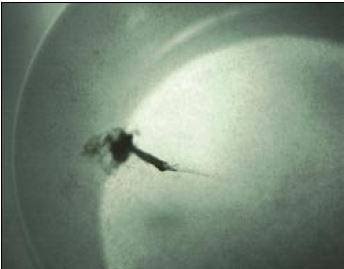5.4.2 Maturation of larvae
Indication that substrate searching behaviour, preparatory to settlement (sometimes termed fixation or setting) and metamorphosis has, or is about to begin, is the appearance – in many species – of a pair of darkly pigmented eye-spot, one on either side between the surface of the digestive gland and the shells valves (Figure 83).
What role the eye-spot actually plays is a matter for conjecture. The appearance of the eye spot is size-related (see later) and coincides with “stringing” or “funneling” behaviour of the larvae en masse when they aggregate together with mucous secretions when transferred from screens to buckets at water change (Figure 84). These are clear signs that larvae are ready to set.

Figure 84: “Stringing” (or “fun neling”) behaviour of mature larvae prior to settlement. The black mass is numerous larvae aggregated together at and just below the water surface in a bucket.
At this time, or a day or two later, larvae will also be seen probing a newly developed foot between the shell valves (Figure 83B). This foot has a ciliated tip and numerous sensory receptors and is used in substrate searching when larvae are seeking a suitable niche to settle and either form a byssus or cement attachment with the chosen location. The foot provides them with the mobility to crawl across surfaces and may also have a feeding (“pedal feeding”) function in some species. It is also the site of byssus or cement glands, depending on species. Oysters form cement attachments with the surface while other bivalves attach with byssus threads. Larvae are referred to as pediveligers at this stage.
There has been considerable controversy as to whether bivalve – and other invertebrate larvae – settle and metamorphose on a rigid schedule or if they select a particular substrate and require a specific cue(s) before the process begins. At present the general belief is that environmental cues influence settlement and metamorphosis and that larvae require specific chemical stimuli before the processes of settlement and metamorphosis are initiated. Studies show these cues are chemicals called neurotransmitters and they must be present to initiate settlement and metamorphosis.